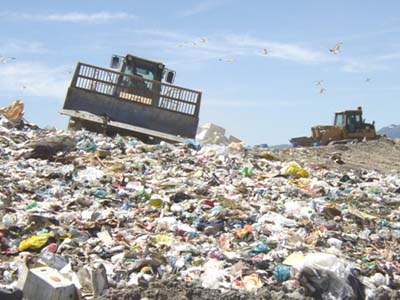
The folks over at Waist Online have a detailed page with allot of useful information about Textile Recycling. They note that textile recycling originated in the Yorkshire Dales about 200 years ago. These days the ‘rag and bone’ men are textile reclamation businesses, which collect textiles for reuse (often abroad), and send material to the ‘wiping’ and ‘flocking’ industry and fibres to be reclaimed to make new garments. Textiles made from both natural and man-made fibres can be recycled.
Why Bother:
It is estimated that more than 1 million tons of textiles are thrown away every year, with most of this coming from household sources. Textiles make up about 3% by weight of a household bin. At least 50% of the textiles we throw away are recyclable, however, the proportion of textile wastes reused or recycled annually in the US is only around 20%.
Although the majority of textile waste originates from household sources, waste textiles also arise during yarn and fabric manufacture, garment-making processes and from the retail industry. These are termed post-industrial waste, as opposed to the post-consumer waste which goes to jumble sales and charity shops. Together they provide a vast potential for recovery and recycling.
Recovery and recycling provide both environmental and economic benefits. Textile recovery:
- Reduces the need for landfill space. Textiles present particular problems in landfill as synthetic (man-made fibres) products will not decompose, while woollen garments do decompose and produce methane, which contributes to global warming.
- Reduces pressure on virgin resources.
- Aids the balance of payments as we import fewer materials for our needs.
- Results in less pollution and energy savings, as fibers do not have to be transported from abroad.
Reclaiming fiber avoids many of the polluting and energy intensive processes needed to make textiles from virgin materials, including: –
- Savings on energy consumption when processing, as items do not need to be re-dyed or scoured.
- Less effluent, as unlike raw wool, it does not have to be thoroughly washed using large volumes of water.
- Reduction of demand for dyes and fixing agents and the problems caused by their use and manufacture.
How, what and where of recycling textiles:
The majority of post-consumer textiles are currently collected by charities like The Salvation Army, Good Will and Chalk. Some charities, for example Good Will and The Salvation Army, sort collected material selling it on to merchants in the appropriate sectors.
Some postindustrial waste is recycled ‘in-house’, usually in the yarn and fabric manufacturing sector. The rest, aside from going to landfill or incineration, is sent to merchants.
Collection Method’s:
At present the consumer has the option of putting textiles in ‘clothes banks’, taking them to charity shops or having them picked up for a donation drive.
The Salvation Army is the largest operator of textile banks in the US. On average, each of these banks is estimated to collect about six tons of textiles per year. Combined with door-to-door collections, The Salvation Army’s textile recycling operations account for the processing of in excess of 17,000 tons of clothing a year. Clothes are given to the homeless, sold in charity shops or sold in developing countries in Africa, the Indian sub-continent and parts of Eastern Europe. Nearly 70% of items put into clothing banks are reused as clothes, and any un-wearable items are sold to merchants to be recycled and used as factory wiping cloths.
Processing and Outlets for Waste Textiles

All collected textiles are sorted and graded at a “Rag House” by highly skilled, experienced workers, who are able to recognize the large variety of fiber types resulting from the introduction of synthetics and blended fiber fabrics. Once sorted the items are sent to various destinations as outlined below:
Post industrial waste is often reprocessed in house. Clippings from garment manufacture are also used by fiber reclaimers to make into garments, felt and blankets.
Some selected items will be sold to the “Vintage Market” and reused by designers fashioning garments and bags from recovered items. Companies like Dust Factory Vintage grade the textiles even more to produce mixes that will sell in trendy Vintage Shops in te US, Japan and Europe, however this is a very small sector within the overall destinations of textiles. For more information on what happens with Vintage Clothing click here.
What You Can Do:
- Take your used clothes to a textile bank. Contact the recycling officer in your local authority if there are no banks in your area and ask why; they may collect textiles through other means. Alternatively you can take used clothing to local charity shops.
- Give old clothes/shoes/curtains/handbags etc. to jumble sales. Remember to tie shoes together: part of the 6% of textiles which is wastage for merchants are single shoes.
- Buy second-hand clothes – you can often pick up unusual period pieces! If bought from a charity shop, it will also benefit a charity.
- Buy things you are likely to wear a long time – a dedicated follower of fashion can also be a green one if items are chosen carefully.
- Look for recycled content in the garments you buy. This should be on the label, though at present there is no conventional marking scheme and some companies do not always advertise the recycled content.
- Buy cloth wipers instead of disposable paper products as the product can be used repeatedly.







Leave a Reply